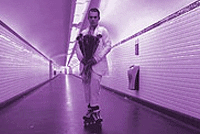In controversial artist Shu Lea Cheang’s first feature Fresh Kill from 1994, a Native American man is the father of a South Asian woman who has a black daughter with her white lover thanks to an East Asian man. Cheang’s
characters cannot be easily classified; they have fluid bodies and identities.
Cheang works with a variety of media to create a totally postmodern world where people are empowered by new technologies. And sex is key to that empowerment. Cheang speaks about her work in Toronto this week as part of the Kodak lecture series at Ryerson University.
She matured as an artist in New York’s queer scene of the 1980s where the lines between artists and activists were blurred. “All this AIDS activism started happening – ACT UP and all that,” she recalls. “At the time, a lot of my friends died. You kind of just live through it without knowing what
happened… it was the time that you challenged the whole sexual representation, the language.”
Cheang made collaborative short videos about dyke visibility, kinship and sexuality. From the start her work addressed a wide range of activist concerns: ecology, corporatization and globalization as well as queer politics. Her work reflects the multicultural realities of big North
American cities and goes even further by imagining a post-racial world.
Cheang’s work is a prime example of the way queer representation could have gone after that crucial peak of radical queer culture; instead, we chose consumer capitalism and Queer Eye For The Straight Guy. Cheang reminds us of the road not taken. Now she has an international reputation in the museum and gallery scene as well as a deep involvement in radical politics and grassroots, accessible art production.
A nomadic artist since 1998, Cheang moves from place to place filming pig farmers making salami one moment and advocating for garlic as a form of currency exchange the next. “In Europe it’s easy to go from country to country. This year I worked in Zurich, Berlin, London, Oslo, Paris. It’s become my lifestyle now. [In] every city I have enough people to support me to make a living. I try not to identify myself with any nation. It is about trying to defy the national borders.”
The two most important themes in all of her work are the sexual body and networked technology. Her cyberporno feature IKU follows a shape-shifting, human-looking robot as she collects data about her partners’ sexual pleasure with a liquid cock appendage. A wide array of body types and practices make their presence felt: FTM, drag queen, bio-girl, bio-boy, orgies, one-on-one, kinky, vanilla, machines and flesh all intersect in this ode to sex equals knowledge equals power.
Community, desire and the body are both form and content of her work, but queerness is just one link in the network. “I think it’s great if my work can be appreciated by the queer community because I don’t really deal with
some pure queer thing. I am a queer, for sure, but I just don’t deal with such a kind of storyline.”
Cheang’s work often creates controversy. Her web project, Milk, which juxtaposes Internet porn with a running tally of AIDS deaths in Africa, raised the hackles of its funders. “I wanted to make a challenging project: Sexual images are there all the time on the ‘net but since this had [Swiss] national culture funding, it got into trouble. They were going to cancel the whole group exhibition so I agreed with the curator that I would make a softcore version. I want to take the credit for the first web artist to ever have to do a hardcore and softcore version!”
Another project is Fluid, which Cheang has been casting with open calls; prospective performers have sex on camera in public. “Anytime a curator asks me to do a sex project it seems like it always gets into trouble. It works out really nice because it is a challenge to the country’s status quo. In Norway, [Fluid] caused such a controversy it’s been on the national news, it’s been debated over, a lot of panel discussions.” While she does run into problems she believes that Europe is still much more open to her work than the United States. “I could never make Fluid in America.”
Cheang has just finished a new film, LOVEME2030, a romance set in Paris that addresses the conflicts and tensions over immigration currently tearing Europe apart. “LOVEME2030 has a lot to do with trying to realize how the whole European city is going through big changes with the ‘new Europeans,’ immigrants from Eastern Europe. Unlike North American cities which are used to the migrant influx and racial mix, in Europe it is still quite fresh. For me it is very exciting, in a way there is still a possibility of making changes.
“The European city would be dead without this influx and mix of cultures.”
She is also currently part of two network performance groups, Mumbai Streaming Attack, which do rush hour “train jams” using an open source sound performance program, and TAKE2030, which “is based on the notion that by the year 2030 the Internet, the wireless, the GPS, everything will go down – and how do you connect? It’s by using DIY technology, free network – this has been my engagement for the past two years, to promote the notion of public wireless network and how it should be shared. We made this performance by having this lunchbox that can test whenever there is a wireless network. It makes noise that we use as the basis for a noise party – hopefully, a dance party.”

 Why you can trust Xtra
Why you can trust Xtra


